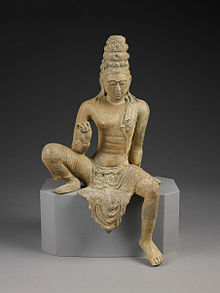Abhayagiri Vihāra was a major monastery site of Mahayana, Theravada and Vajrayana Buddhism that was situated in Anuradhapura, Sri Lanka. It is one of the most extensive ruins in the world and one of the most sacred Buddhist pilgrimage cities in the nation. Historically it was a great monastic centre as well as a royal capital, with magnificent monasteries rising to many stories, roofed with gilt bronze or tiles of burnt clay glazed in brilliant colors. To the north of the city, encircled by great walls and containing elaborate bathing ponds, carved balustrades and moonstones, stood "Abhayagiri", one of seventeen such religious units in Anuradhapura and the largest of its five major viharas. One of the focal points of the complex is an ancient stupa, the Abhayagiri Dagaba. Surrounding the humped dagaba, Abhayagiri Vihara was a seat of the Northern Monastery, or Uttara Vihara and the original custodian of the Tooth relic in the island.
The term "Abhayagiri Vihara" refers not only to the complex of monastic buildings, but also a fraternity of Buddhist monks, or Sangha, which maintained its own historical records, traditions and way of life. Founded in the 2nd century BC, it had grown into an international institution by the 1st century AD, attracting scholars from all over the world and encompassing all shades of Buddhist philosophy. Its influence can be traced to other parts of the world, through branches established elsewhere. Thus, the Abhayagiri Vihara developed as a great institution vis‑a‑vis the Mahavihara and the Jetavana Buddhist monastic sects in the ancient Sri Lankan capital of Anuradhapura.
The golden age of Abhayagiri
Bronze statue of Avalokiteśvara Bodhisattva. Sri Lanka, ca. 750 CE
Royal patronage
Under Gajabahu I, Abhayagiri grew in prestige and importance.The accession of King Mahasena in the 3rd century AD saw the suppression of the Mahavihara monks. The king prohibited the giving of alms to them and went as far as to demolish the buildings of the Mahavihara and re‑use their materials for the construction of new buildings at the Abhayagiri. The accession of Mahasena ushered in the golden age of Abhayagiri. After the Buddha's Tooth Relic was brought to Sri Lanka in the 4th century, Abhayagiri was selected to house it for public veneration.
Faxian, a Chinese monk, recounted:
Ten days from now, Buddha's tooth will be brought out and carried to the Abhayagiri Monastery... on both sides of the road; the king sets images of the Five Hundred Forms which the Buddha assumed in his previous existence.
By the time Faxian came to Sri Lanka in search of the Dhamma and visited Abhayagiri in 412 AD, it had developed into a leading Buddhist centre of Sri Lanka. By the 7th century, Abhayagiri Vihara consisted of four mulas (literally "families", fraternities or grouped institutions for religious teaching):
Uttara‑mula
Kapara‑mula
Mahanethpa‑mula
Vahadu‑mula
All of these have been located and identified through archaeological excavations, research and epigraphical evidence.
Before the 12th century CE, more rulers of Sri Lanka gave support and patronage to the Abhayagiri Theravādins, and travelers such as Faxian saw the Abhayagiri Theravādins as the main Buddhist tradition in Sri Lanka.
Foreign relations
In the course of time, Abhayagiri had developed into a well‑organized religious and educational institution having well established relations with China, Java, and Kashmir.
According to the Chinese text Biqiuni Zhuan, the biography of the bhikkhuni compiled by Shi Baochang in 526 AD, and the biography of Gunavarnam and Sanghavarnam, the Sinhala nuns gave the second Upasampada, or higher ordination, to the Chinese nuns. According to another Chinese source, in 426 AD, eight Sinhala nuns arrived in Nanjing, the capital of the Liu Song dynasty (420–77 AD), on a merchant ship owned by man named Nandi. Consequently, three more nuns, headed by Tissara, arrived in Nanjing. Thus in the year 434, over three thousand nuns received their higher ordination for the second time in the presence of more than ten Sinhala nuns headed by Tissara at the Nanjing Temple in China.
It is also recorded that there were religious contacts between Sri Lanka and Java through the Abayagiri Vihara, at least toward the end of 8th century, as described by a fragmentary inscription from the Ratubaka plateau in central Java. This inscription records the establishment of "the Abhayagiri Vihara of Sinhalese ascetics trained in the sayings of jinas [Buddhas]." Commenting on this record, J.G. de Casparis observes, 'The most important detail is the name of the foundation, the Abhayagiri Vihara.
Mahāyāna and Vajrayāna
Abhayagiri Vihara appears to have been a center for Mahāyāna and Vajrayāna teachings;[8] as such, it was seen as heretical by more conservative Mahavihara monks.[9] In the 7th century CE, Xuanzang also describes the concurrent existence of both monasteries in Sri Lanka, and refers to the monks of the Mahavihara as the "Hīnayāna Sthaviras" (Pali: Thera), and the monks of the Abhayagiri Vihara as the "Mahāyāna Sthaviras."Xuanzang further writes:
The Mahāvihāravāsins reject the Mahāyāna and practice the Hīnayāna, while the Abhayagirivihāravāsins study both Hīnayāna and Mahāyāna teachings and propagate the Tripiṭaka.
As a major university and center of learning, Abhayagiri was the home of various important Buddhist scholars working in Sanskrit and Pali. These include Upatissa (who wrote the Vimuttimagga), Kavicakravarti Ananda (authored the Saddhammopåyana), Aryadeva, Aryasura, and the tantric masters Jayabhadra, and Candramåli.
In the 8th century CE, it is known that both Mahāyāna and the esoteric Vajrayāna form of Buddhism were being practiced in Sri Lanka, and two Indian monks responsible for propagating Esoteric Buddhism in China, Vajrabodhi and Amoghavajra, visited the island during this time.












